Montreal is Canada’s second largest city, and it is one of the French-speaking world’s largest cities. Montreal is also famous for design and architecture that goes far back in the city’s history. Visitors can enjoy preserved buildings dating back to the 17th century and many landmarks from the following centuries.
The Old Town offers many activities and beautiful sights. The Notre-Dame Basilica and the large Bonsecours market are two of the buildings you should definitely see, and you can also take a stroll along Rue Saint Jacques to see some 19th century headquarters for Canada’s major banks.
Newer buildings include, for example, the Catholic Oratoire Saint-Joseph du Mont-Royal, the university’s primary campus in Art Deco and the distinctive Habitat 67, which was constructed as a model for a newly designed residential complex for the 1967 World Exhibition in the city.
There are also ample opportunities for recreation in the city. The Mont Royal hill at the city center reaches a height of 234 meters/768 feet at the highest of it’s three peaks. You can also take a boat trip on the St Lawrence River and enjoy a trip to the islands of Île Sainte-Hélène and Île Notre-Dame.
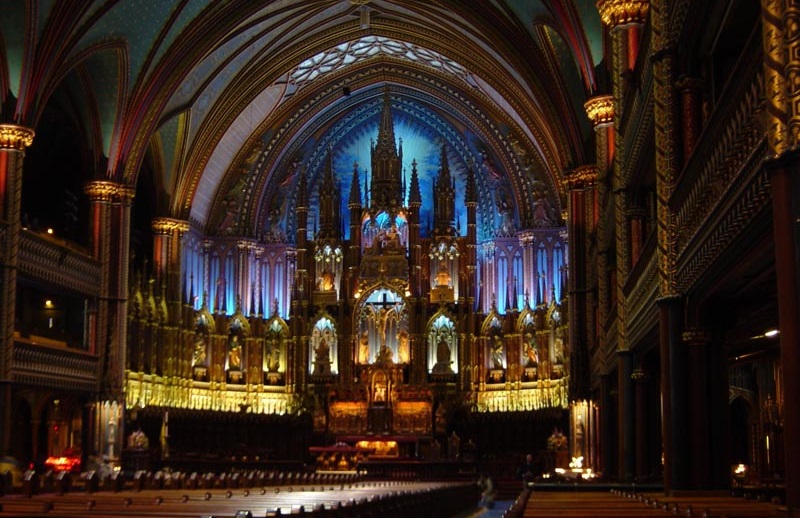
Basilique Notre-Dame is Montréal’s impressive cathedral, built in the Neo-Gothic style in the years 1824-1829. The building is famous for its very beautiful interior with the fantastic wood carvings, paintings and lots of gilding.
The history of the church dates to the arrival of the Sulpician order in what was then Ville-Marie in 1657. Six years later they gained dominion over the island on the site, which they ruled until 1840. The Sulpicians founded the parish of Notre-Dame and built the church of the same name in 1672. In the 1820s the congregation had grown and the church had become too small.
The architect James O’Donnell was appointed to design a new and larger cathedral that would be able to accommodate 10,000 churchgoers. O’Donnell designed a magnificent neo-Gothic building, which was mostly completed in 1829. The following year, James O’Donnell died, converting to Catholicism on his deathbed, allowing him to be buried in the cathedral’s crypt.
Construction continued after 1829, and the two towers were completed in 1841 and 1843, respectively. At the time of completion, the Basilique Notre-Dame was the largest church in North America. However, craftsmen continued to work on the decoration for several years. The facade was completed in 1865, while the interior decoration of the church was worked on until 1879.
You can enjoy the view of the cathedral’s facade before entering the unforgettably beautiful interior, which is a neo-Gothic masterpiece. The vaults are colored deep blue and decorated with golden stars, while the play of colors in the rest of the church is blue, azure, red, purple, silver and gold. There are countless wood carvings, statues and stained-glass windows depicting scenes from Montreal’s religious history.
Jardin Botanique is Montréal’s beautiful botanical garden, considered one of the world’s leading of its kind. In the approximately 30 gardens and 10 greenhouses in the 75-hectare botanical garden, you can experience more than 22,000 plants, and it is a pleasure to enjoy the surroundings on a trip here.
The garden was founded in 1931 and laid out according to a design by Henry Teuscher. In the garden you can see the contemporary administration building, which stands in beautiful art deco according to Lucien F. Kéroack’s design, and you can also see the Lion de la Feuillée monument, which is a lion from 1831 that originally adorned a bridge in Lyon, France. The lion came to Montreal in 1992.
There are several thematic gardens and facilities in the Jardin Botanique. For example, you can visit the Chinese garden, which was laid out in accordance with the traditions from the time of the Ming Dynasty. There is also a Japanese garden that is home to tea ceremonies. You can enjoy an alpine garden as well and a facility with totem poles from Canada’s indigenous population.
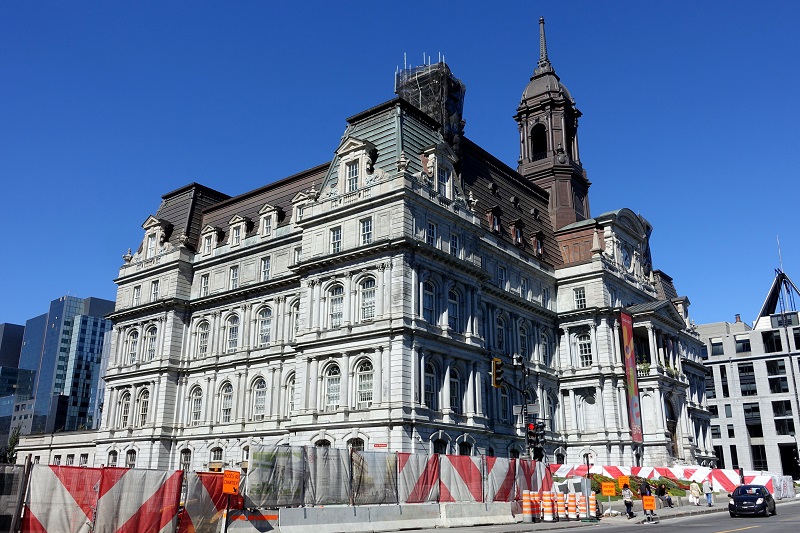
Hôtel de Ville is Montréal’s town hall and one of the city’s characteristic buildings from the latter half of the 19th century. The town hall was designed by the architects Henri-Maurice Perrault and Alexander Cowper Hutchison and built in the years 1872-1878.
The elegant city hall building stands as one of the best examples of the Napoleon III style, also known as the second empire, in Canada. Unfortunately, the town hall burned down in 1922, leaving only the walls standing. During the reconstruction, the old walls were kept and a new town hall was built behind them.
Vieux Séminaire Saint-Sulpice is the name of one of Montreal’s oldest buildings. It is an old seminary that was built in 1684-1687 in a style that represented official Nouvelle France. The building’s clock dates from 1701, making it North America’s oldest of its kind.
The seminary was already founded in 1657 by the Sulpician Order, but 27 years passed before the construction of the building began under the direction of François Dollier de Casson, who was the leader of the Sulpicians in Montreal. The purpose of the seminary was to train secular priests and to carry out missions among the indigenous population of the colony.
In accordance with a monastic tradition, the Sulpicians planted a garden in the 17th century close to their seminary to grow fruit and vegetables. The garden was established in the French tradition from the Renaissance with a geometric arrangement of the passages with lawns and a central statue. The Garden of the Order is one of the oldest gardens of its kind in North America.
Place d’Armes is an important square in Montreal’s Old Town. It was laid out in 1693 and called Place de la Fabrique before it got its current name in 1721 when it was used for various military events. Later, the square was set up with markets before a Victorian garden was established here.
The square got its current size in the 1830-1840s, when the Basilique Notre-Dame replaced an earlier church on the site. The old church was located in front of today’s cathedral and thus on the area of the square itself. In the middle of the square you can see a statue. Depicting King George III, it was erected in 1773 as the first public monument of its kind in Montréal.
There are several interesting buildings around the Place d’Armes. To the east you can see the Catholic cathedral, Basilique Notre-Dame, and the old 17th-century seminary Vieux Séminaire Saint-Sulpice. To the north is the red stone building Édifice New York Life, which was inaugurated in 1889 as the city’s first high-rise. Next to it stands Édifice Aldred from 1931 in art deco. To the west you can see the Pantheon-like Édifice de la Banque de Montréal, built in 1847.
Oratoire Saint-Joseph is a Roman Catholic basilica located in the southwestern part of the Parc du Mont-Royal in Montréal. The basilica is a huge building that literally stands as the top of the city, with the great dome reaching more than 30 meters above the top of the Mont Royal hill.
In 1904, the monk André Bessette was able to build a small chapel on this site, and the chapel became the predecessor of today’s large church. The chapel was expanded over the following decade, and due to André Bessette’s great international popularity and merits, the church allowed him to build a basilica to replace the chapel, which was moved to be preserved.
From 1914 to 1916, the church’s crypt was built, where there was room for 1,000 churchgoers. The following decades until its completion in 1967, the basilica was built, and the long construction time meant that several architectural styles were used. You can thus see renaissance style in the 1920s parts of the church and art deco in later elements.
The mighty result can be seen today. The basilica is 105 meters long and 65 meters wide, and the top of the dome reaches a height of 97 meters. All parts of the church are worth seeing, from the neoclassical-inspired crypt with a marble figure of Saint Joseph to the large interioe with its elegant lines and the La Chapelle Votive chapel.
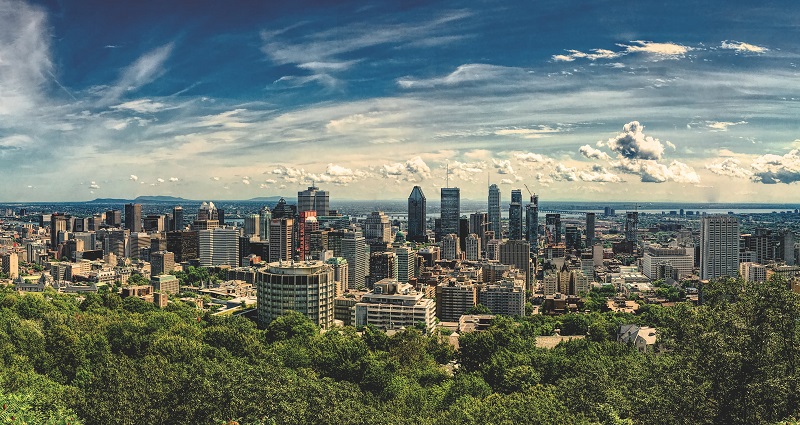
Mont-Royal is a hill located almost in the middle of Montréal. It has a height of 233 meters and from the top you can enjoy an excellent view. Not least from the location Chalet du parc du Mont-Royal, where you can see the city center and St. Lawrence River as an unforgettable panorama.
The hill consists of three peaks, of which Grosse Montagne or Colline Mont-Royal is 233 meters high, and in addition l’Outremont at 211 meters and Petite Montagne or Sommet Westmount at 201 meters. It was explorer Jacques Cartier who gave the hill its name, and thereby is believed to have given the city of Montréal its name in 1535.
On the hill, you can go for some lovely walks in the Parc du Mont-Royal, which is one of Montreal’s great green oases. It was Frederick Law Olmsted who designed the park, which was opened in 1876. You can see various installations, sculptures and a varied flora and fauna in the park.
Musée McCord Stewart is an interesting museum of Canadian history and culture. It is a museum that took its starting point from the collection that David Ross McCord established from 1878, and at that time the McCords already had a significant collection from their time in Canada. David Ross McCord planned over the years to found a national history museum in Montréal, and the plan was realized in 1921.
At the museum, you can see exhibitions within different themes and cultures. For example, you can see a collection of countless objects that depict ways of life, art, cultures and traditions of the indigenous cultures in, among other places, Québec. You can also see the country’s finest collection of textiles and clothing, created by Montréal’s greatest designers. There are also other collections within handicrafts, documentary art and so on.
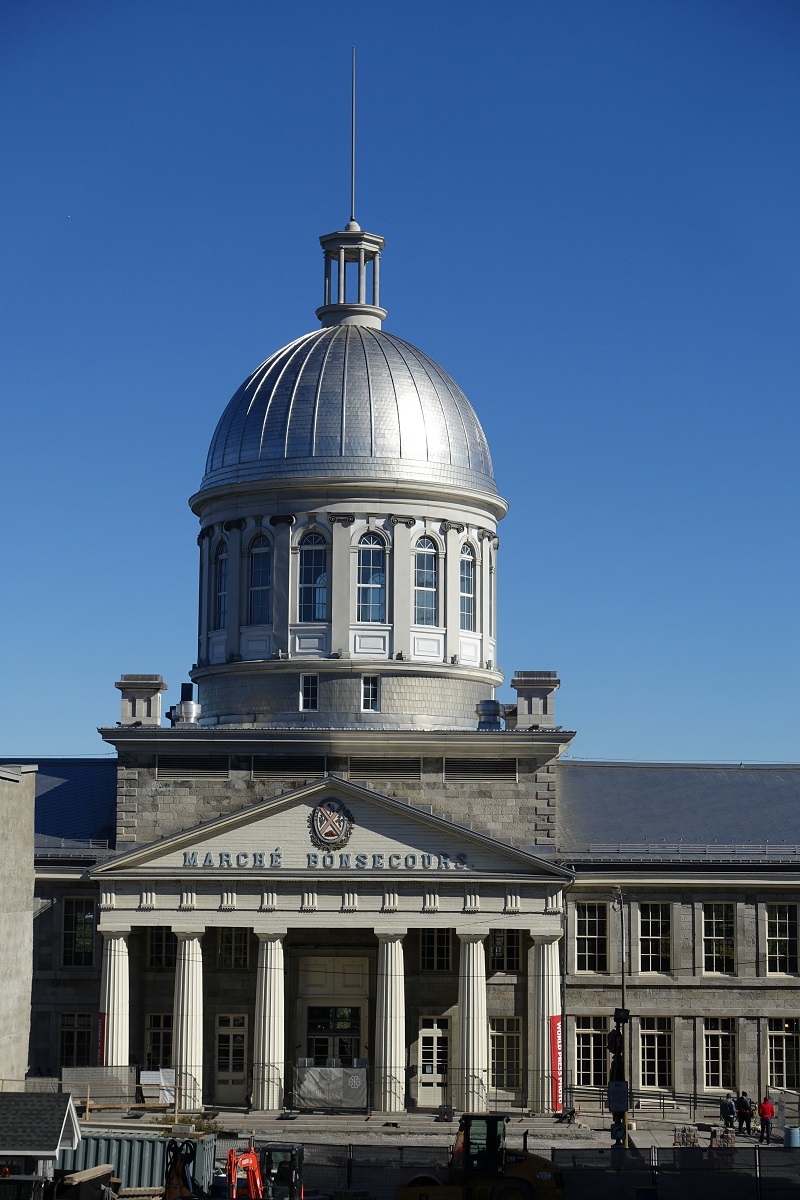
Marché Bonsecours is an impressive market building that was built 1844-1847 as Montréal’s produce market. The large building is today a beautiful place with shops, restaurants and halls for various events.
The market took its name from the nearby church Chapelle Notre-Dame-de-Bon-Secours and was designed by British William Footner, who was architecturally inspired by the Customs House in Dublin, Ireland. The style chosen was neoclassical with a large dome as the central element.
Marché Bonsecours opened as a commercial building, but there were also other activities. In 1849, the Legislative Assembly of the Province of Canada met in the building that also housed Montreal’s City Hall in the years 1852-1878. Exhibitions and banquets were also held here.
Tour de Montréal & Parc Olympique are parts of the large facility where the Summer Olympic Games were held in Montréal in 1976. Included in the facility was the construction of one of the city’s current landmarks, the Tour de Montréal, which was the characteristic tower of the Olympic park.
The Tour de Montréal was designed by French architect Roger Taillibert, and it was built with a 45-degree incline. The height of 165 made the tower the world’s highest leaning tower, and the inclination considerably exceeds that of, for example, the Leaning Tower of Pisa.
The tower is the pylon for the cables that connect it to the roof of the Olympic stadium, the Stade Olympique, and in the tower there is an observation deck with an exhibit about both the Olympic park and about Montréal’s Olympic Games and highlights from them.
Parc Olympique is the Olympic park of which Tour de Montréal and Stade Olympique are parts. The large stadium was the centerpiece of the Games in 1976, and subsequently it has been used for concerts and as the home ground for Montreal’s football and baseball teams.
Next to the Tour de Montréal is the Biodôme de Montréal, which offers a tour through different ecosystems from the American continents. During the Olympic Games, the building was the arena for cycling and for judo competitions.
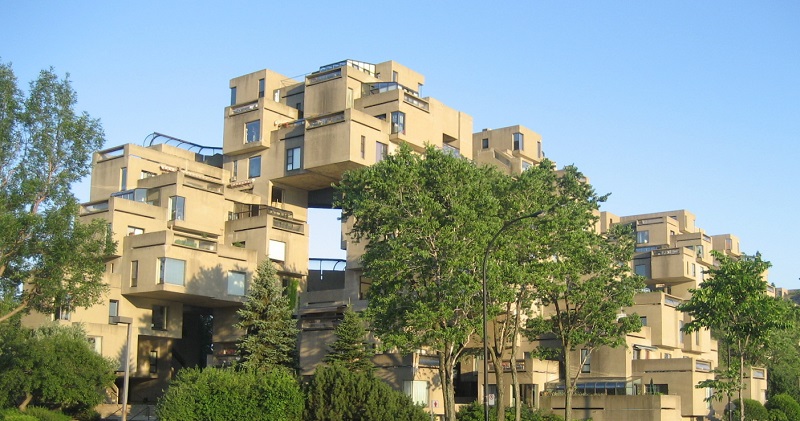
Habitat 67 is an interesting housing complex that was created in Montréal for the World’s Fair held in the city in 1967. It was Canadian-Israeli architect Moshe Safdie who designed the project as part of his graduation project from McGill University.
Habitat 67 consists of 354 identical concrete forms of 11.7x5x3 meters each, which were arranged in different compositions in three types of pyramids of up to twelve residential floors in height. At the opening, the result was 156 apartments of various sizes and furnishings.
All the apartments had access to terraces or the roof terraces, and it was also an aim to integrate fresh air and small gardens with urban life in an apartment building.
Habitat 67 was built in the Cité-du-Havre area, which was created by land fills due to the desire to protect Montréal’s harbor from icy conditions. Today, you can enjoy the unique construction from different angles, which give varied impressions.
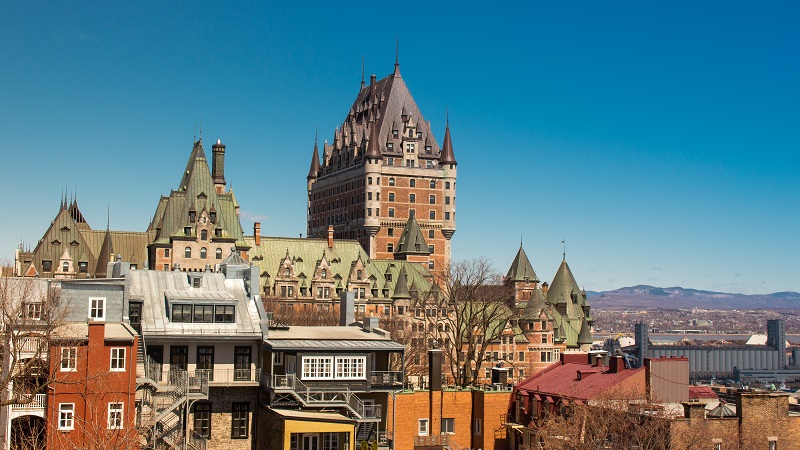
Quebec is the capital of the French-speaking Canadian province of the same name as the city. After Montreal, it is the province’s largest city and it offers numerous sights and activities for locals and visitors alike.
Founded in 1608, the city is Canada’s second oldest city. In early Québec, walls and fortifications were built around the city according to European model, and they can still be seen as the only one of its kind in the United States and Canada. The walls surround the old town, Vieux-Québec, which is included in the UNESCO World Heritage List.
Les Laurentides is an area located northwest of Montréal and known for its beautiful and mountainous nature. The area is worth a visit in both summer and winter, and there are plenty of places to choose from. The sights and activities are mainly found along the main road between Montréal and Mont-Laurier.
In the summer, the mountains invite you to hikes where you get into the wilderness, and there are also good opportunities for bike rides, golf, ziplining and trips in canoes or kayaks. Of course, you can also just make a drive in nature and enjoy views of lakes and forests in the large area.
In winter, there is also the possibility of hiking, but of course also to visit the many ski resorts located in Les Laurentides. You can find both alpine hills and good cross-country trails, and you can also try snowmobiles in the magnificent landscape.
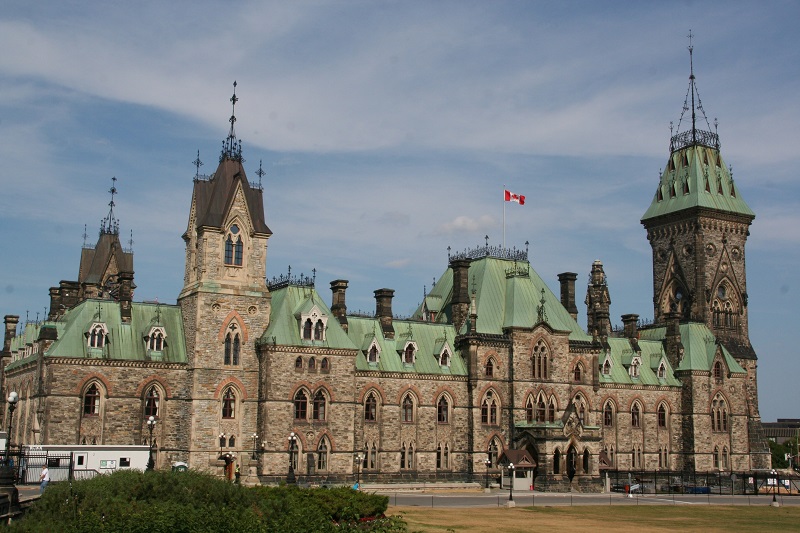
Ottawa is Canada’s capital and it is located in Ontario on the border between English-speaking and French-speaking Canada. Thus, on the opposite bank of the Ottawa River is the town of Gatineau, which is part of the metropolitan area surrounding the capital.
In Ottawa there are many sights, and of course the Canadian government buildings are among the best known. The main building on Parliament Hill is the so-called Center Block, which stands in neo-Gothic architecture, that is clearly seen inside, for example, in the Confederation Hall and in the Hall of Honor.
705 Rue Ste-Catherine W
centreeatondemontreal.com
150 Rue Ste-Catherine W
complexedesjardins.com
1616 Rue Ste-Catherine W
lefaubourg.com
350 Rue Saint-Paul Est
marchebonsecours.qc.ca
1500 Avenue McGill College Ave
placemontrealtrust.com
Place Ville Marie
placevillemarie.com
Rue Sherbrooke, Rue Ste-Catherine, Rue Saint Hubert, Chinatown
Exporail/Canadian Railway Museum
110 Saint-Pierre
exporail.org
Zoo de Granby
525 Rue Saint-Hubert
zoodegranby.com
Planétarium de Montréal
1000 Rue Saint-Jacques
planetarium.montreal.qc.ca
Super Aqua Club
322 Montée de la Baie, Pointe-Calumet
superaquaclub.com
La Ronde
Île-Sainte-Hélène
laronde.com
For several thousand years there have been settlements in the Montreal area. The Native American tribes Algonquin, Huron and Iroquois were represented here.
The first Europeans to come to Canada were Scandinavian Vikings – and the first to come to present-day Montreal is Jacques Cartier. He arrived in the Native American village of Hochelega in 1535. However, the first visit did not result in a permanent French settlement.
In the early 1600s, Samuel de Champlain decided to establish a trading station at Port Royal on Montréal Island. The trade was mainly with the many furs of the area.
A few years later, in 1639, the first real European settlement was founded. Jérôme le Royer settled, and in 1642 the missionaries Paul Chomedey de Maisonneuve and Jeanne Mance accompanied the establishment of the mission of Marie Marie.
Ville Marie quickly became the center of fur trade, for the Catholic Church and for the spread of the French colony of New France. However, the European settlement did not happen peacefully. The Iroquois Indians carried out continuous attacks against the French until a peace treaty was concluded in 1701.
The development of the city was strong in the first half of the 18th century, and the English interest in French territory grew steadily over the years. After the attack and siege, Pierre de Cavagnal, the Marquis of Vaudreuil, surrendered the city to the English troops under the leadership of Jeffrey Amherst. That action ended the formal French rule over Montreal, which the city was eventually known as. Three years later, France had to surrender all of New France to England.
The English development of Montréal was initially hampered by a major fire in 1765. Around a quarter of the city burned down. A rebuilding took place and the city’s flourishing really took off with a marked English immigration.
It was also during this time that the fur trade grew to new heights with economic benefit to the whole city as a result. The local North West Company was created for the occasion and it competed against the otherwise dominant Canadian Hudson’s Bay Company.
The continued development of Montreal as a regional center was reinforced in the early 1800s. The original French plan for the construction of canals as a transport route from Inner Canada to Montreal was implemented, and in 1825 the significant Canal du Lachine was completed. The canal enabled faster and larger shipments directly to the Port of Montreal, where goods could be shipped to ships crossing the Atlantic.
Montreal gained the status of a major city in 1832, and during the period 1844-1849 the city was the capital of the United Canadian province. It brought more Englishmen to the town, which was eventually bilingual. The English founded McGill University, and wealthy families began the expansion of the area around Mont Royal.
In the mid-1800s, 60,000 people lived in Montreal, and it was the largest city in English North America. The city was also the absolute economic and cultural center. Rue Saint Jacques became the English answer to US Wall Street, and the major Canadian railroad companies were established in the city.
In 1883 and again in 1918, Montreal was merged with surrounding urban areas, which in turn made the city’s clear majority French, which through the 1900s became more dominant in the guided politics.
After a crisis following the stock market crash in 1929, and the subsequent North American depression, some development started in the mid-1930s. Skyscrapers were erected and many newcomers joined. By 1950, the population had grown to over a million, and the city continued to grow rapidly. Plans were made for the establishment of a metro, the underground city and new port and sailing facilities.
Within ten years, Montreal was the frame of considerable media interest. In 1967, the city hosted the World Exhibition, and in 1976 the Olympic Games were held here.
The last decades of the 1900s were a tremendous period of growth for Montreal’s high-tech industry. The telecommunications and pharmaceutical industries are just a few examples of the industry that has helped form the foundation of today’s modern Montreal.
The positive development of French culture and French as a used language in Quebec in recent decades has led to some relocation of English-speaking Canadians to, among other things. Toronto, and today French culture is also the dominant culture in the city.

Overview of Montreal
Montreal is Canada’s second largest city, and it is one of the French-speaking world’s largest cities. It is also famous for design and architecture that goes far back in the city’s history. Visitors can enjoy preserved buildings dating back to the 17th century and many landmarks from the following centuries.
The Old Town offers many activities and beautiful sights. The Notre-Dame Basilica and the large Bonsecours market are two of the buildings you should definitely see, and you can also take a stroll along Rue Saint Jacques to see some 19th century headquarters for Canada’s major banks.
About the upcoming Montreal travel guide
About the travel guide
The Montreal travel guide gives you an overview of the sights and activities of the Canadian city. Read about top sights and other sights, and get a tour guide with tour suggestions and detailed descriptions of all the city’s most important churches, monuments, mansions, museums, etc.
Montreal is waiting for you, and at vamados.com you can also find cheap flights and great deals on hotels for your trip. You just select your travel dates and then you get flight and accommodation suggestions in and around the city.
Read more about Montreal and Canada
Buy the travel guide
Click the “Add to Cart” button to purchase the travel guide. After that you will come to the payment, where you enter the purchase and payment information. Upon payment of the travel guide, you will immediately receive a receipt with a link to download your purchase. You can download the travel guide immediately or use the download link in the email later.
Use the travel guide
When you buy the travel guide to Montreal you get the book online so you can have it on your phone, tablet or computer – and of course you can choose to print it. Use the maps and tour suggestions and you will have a good and content-rich journey.
Notre-Dame • Parc du Mont Royal • Habitat 67 • Bonsecours

Overview of Montreal
Montreal is Canada’s second largest city, and it is one of the French-speaking world’s largest cities. It is also famous for design and architecture that goes far back in the city’s history. Visitors can enjoy preserved buildings dating back to the 17th century and many landmarks from the following centuries.
The Old Town offers many activities and beautiful sights. The Notre-Dame Basilica and the large Bonsecours market are two of the buildings you should definitely see, and you can also take a stroll along Rue Saint Jacques to see some 19th century headquarters for Canada’s major banks.
About the upcoming Montreal travel guide
About the travel guide
The Montreal travel guide gives you an overview of the sights and activities of the Canadian city. Read about top sights and other sights, and get a tour guide with tour suggestions and detailed descriptions of all the city’s most important churches, monuments, mansions, museums, etc.
Montreal is waiting for you, and at vamados.com you can also find cheap flights and great deals on hotels for your trip. You just select your travel dates and then you get flight and accommodation suggestions in and around the city.
Read more about Montreal and Canada
Buy the travel guide
Click the “Add to Cart” button to purchase the travel guide. After that you will come to the payment, where you enter the purchase and payment information. Upon payment of the travel guide, you will immediately receive a receipt with a link to download your purchase. You can download the travel guide immediately or use the download link in the email later.
Use the travel guide
When you buy the travel guide to Montreal you get the book online so you can have it on your phone, tablet or computer – and of course you can choose to print it. Use the maps and tour suggestions and you will have a good and content-rich journey.

Mont-Royal is a hill located almost in the middle of Montréal. It has a height of 233 meters and from the top you can enjoy an excellent view. Not least from the location Chalet du parc du Mont-Royal, where you can see the city center and St. Lawrence River as an unforgettable panorama.
The hill consists of three peaks, of which Grosse Montagne or Colline Mont-Royal is 233 meters high, and in addition l’Outremont at 211 meters and Petite Montagne or Sommet Westmount at 201 meters. It was explorer Jacques Cartier who gave the hill its name, and thereby is believed to have given the city of Montréal its name in 1535.
On the hill, you can go for some lovely walks in the Parc du Mont-Royal, which is one of Montreal’s great green oases. It was Frederick Law Olmsted who designed the park, which was opened in 1876. You can see various installations, sculptures and a varied flora and fauna in the park.
Musée McCord Stewart is an interesting museum of Canadian history and culture. It is a museum that took its starting point from the collection that David Ross McCord established from 1878, and at that time the McCords already had a significant collection from their time in Canada. David Ross McCord planned over the years to found a national history museum in Montréal, and the plan was realized in 1921.
At the museum, you can see exhibitions within different themes and cultures. For example, you can see a collection of countless objects that depict ways of life, art, cultures and traditions of the indigenous cultures in, among other places, Québec. You can also see the country’s finest collection of textiles and clothing, created by Montréal’s greatest designers. There are also other collections within handicrafts, documentary art and so on.

Marché Bonsecours is an impressive market building that was built 1844-1847 as Montréal’s produce market. The large building is today a beautiful place with shops, restaurants and halls for various events.
The market took its name from the nearby church Chapelle Notre-Dame-de-Bon-Secours and was designed by British William Footner, who was architecturally inspired by the Customs House in Dublin, Ireland. The style chosen was neoclassical with a large dome as the central element.
Marché Bonsecours opened as a commercial building, but there were also other activities. In 1849, the Legislative Assembly of the Province of Canada met in the building that also housed Montreal’s City Hall in the years 1852-1878. Exhibitions and banquets were also held here.
Tour de Montréal & Parc Olympique are parts of the large facility where the Summer Olympic Games were held in Montréal in 1976. Included in the facility was the construction of one of the city’s current landmarks, the Tour de Montréal, which was the characteristic tower of the Olympic park.
The Tour de Montréal was designed by French architect Roger Taillibert, and it was built with a 45-degree incline. The height of 165 made the tower the world’s highest leaning tower, and the inclination considerably exceeds that of, for example, the Leaning Tower of Pisa.
The tower is the pylon for the cables that connect it to the roof of the Olympic stadium, the Stade Olympique, and in the tower there is an observation deck with an exhibit about both the Olympic park and about Montréal’s Olympic Games and highlights from them.
Parc Olympique is the Olympic park of which Tour de Montréal and Stade Olympique are parts. The large stadium was the centerpiece of the Games in 1976, and subsequently it has been used for concerts and as the home ground for Montreal’s football and baseball teams.
Next to the Tour de Montréal is the Biodôme de Montréal, which offers a tour through different ecosystems from the American continents. During the Olympic Games, the building was the arena for cycling and for judo competitions.

Habitat 67 is an interesting housing complex that was created in Montréal for the World’s Fair held in the city in 1967. It was Canadian-Israeli architect Moshe Safdie who designed the project as part of his graduation project from McGill University.
Habitat 67 consists of 354 identical concrete forms of 11.7x5x3 meters each, which were arranged in different compositions in three types of pyramids of up to twelve residential floors in height. At the opening, the result was 156 apartments of various sizes and furnishings.
All the apartments had access to terraces or the roof terraces, and it was also an aim to integrate fresh air and small gardens with urban life in an apartment building.
Habitat 67 was built in the Cité-du-Havre area, which was created by land fills due to the desire to protect Montréal’s harbor from icy conditions. Today, you can enjoy the unique construction from different angles, which give varied impressions.
Similar to Montreal Travel Guide